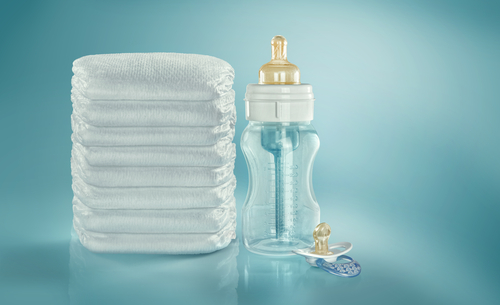Antipyretics for children are prescribed by a pediatrician. But there are emergency situations with fever when the child needs to be given medicine immediately. Then the parents take responsibility and use antipyretic drugs. What is allowed to be given to infants? How can you lower the temperature in older children? What medications are the safest?
Worries about whether her baby has enough milk happens at least once to every young mother, especially in the first months after childbirth. Unfortunately, for many mothers, doubts about the sufficiency of milk end with the transfer of the baby to artificial feeding. Often, when faced with the first difficulties, a woman makes a hasty conclusion about her hopeless “non-dairy” (although the amount of breast milk may be quite sufficient) and, with the “support” of grandmothers or friends, who often have no experience of successful breastfeeding, begins to supplement the baby with formula or completely refuses breastfeeding. Most often, this happens due to a lack of knowledge about the mechanism of lactation and the criteria by which a mother can independently verify whether her baby has enough milk.
What you need to know about lactation
The main role in the mechanism of lactation is played by two hormones - prolactin and oxytocin. They begin to be produced by the pituitary gland immediately after childbirth.
Prolactin is a hormone responsible for the secretion of breast milk. The amount of milk a mother has depends on it: the more prolactin the pituitary gland produces, the more milk in the mother’s breast. Active production of prolactin is promoted by regular and complete emptying of the mammary gland and vigorous sucking of the breast by a hungry baby. The more often and more actively the baby sucks the breast and empties it well, the greater the release of prolactin and, accordingly, the greater the amount of milk will be formed. This is how the “supply and demand” principle works, and the baby receives as much milk as he needs.
Prolactin is produced most at night and in the early morning hours, so it is very important to maintain night feedings in order to provide the baby with milk during the next day.
The second hormone actively involved in the lactation process is oxytocin. This hormone promotes the release of milk from the breast. Under the influence of oxytocin, the muscle fibers located around the lobules of the mammary gland contract and squeeze milk into the ducts towards the nipple. Decreased oxytocin production makes it difficult to empty the breast, even if there is milk in it. In this case, the child has to make significant efforts to extract, so during feeding he may behave restlessly and even get angry. When trying to express milk, in this case, the mother will be able to squeeze out only a few drops from the breast, remaining fully confident that she has little milk. The amount of oxytocin produced depends on the emotional state of the mother. The more positive emotions and pleasure a woman receives, the more this hormone is produced. While stress, anxiety and other negative emotions reduce the production of oxytocin, since this releases a large amount of the “anxiety hormone” adrenaline into the blood - the worst “enemy” of oxytocin, blocking its production. This is why a comfortable and calm environment around her and her baby is so important for a nursing woman.
Why did breast milk run away?
Lactation is a very fluid process, which is influenced by many different factors (the mother’s health, the frequency of feedings, the severity of the baby’s sucking reflex, etc.). cannot be produced “on schedule”, and for certain reasons its quantity may decrease. Insufficient milk production in the mother is called hypogalactia. Depending on the causes that cause it, primary and secondary hypogalactia are distinguished.
Primary hypogalactia is a true inability to lactation, which occurs in only 3-8% of women. It usually develops in mothers suffering from endocrine diseases (diabetes mellitus, diffuse toxic goiter, infantilism and others). With these diseases, the mother’s body often experiences underdevelopment of the mammary glands, as well as disruption of the processes of hormonal stimulation of lactation, as a result of which her mammary glands are simply not able to produce a sufficient amount of milk. It is quite difficult to treat this form of hypogalactia; in such cases, hormonal drugs are prescribed.

Secondary hypogalactia is much more common. A decrease in milk production is mainly associated with improperly organized breastfeeding (irregular attachment to the breast, long breaks between feedings, improper latching of the breast), as well as physical and mental fatigue, lack of sleep, poor diet, and illnesses of the nursing mother. The causes of hypogalactia can also be complications of pregnancy, childbirth and the postpartum period, prematurity of the baby, taking certain medications and much more. A decrease in lactation can be triggered by a mother’s reluctance to breastfeed her baby or her lack of confidence in her own abilities and a preference for artificial feeding. In most cases, secondary hypogalactia is a temporary condition. If the cause that caused the decrease in milk production is correctly identified and eliminated, lactation will normalize within 3–10 days.
All of the above situations are true forms of hypogalactia, which are still not as common as false, or imaginary, hypogalactia, when a nursing mother produces enough milk, but at the same time she is convinced that she does not have enough milk. Before sounding the alarm and running to the store for a package of formula, the mother needs to figure out whether she really has little milk.
Does the baby have enough milk?
You can quickly and reliably determine whether your baby has enough milk by counting the number of times he urinates. Do a “wet diaper” test: to do this, you need to count the number of times your baby urinates in 24 hours, without using disposable diapers and changing the diaper every time your baby pees. The test is considered objective if the child is exclusively breastfed and is not supplemented with water, baby teas or other liquids. If the baby has soiled 6 or more diapers, and the urine is light, transparent and odorless, then the amount of milk he receives is quite enough for his normal development, and supplementary feeding is not required in this situation. If urination is rare (less than 6 times a day), and the urine is concentrated and has a strong odor, this is a sign that the baby is starving and it is necessary to take active measures to restore lactation.
Another reliable criterion for assessing the sufficiency of nutrition and normal development of a child is the dynamics of weight gain. Although the child’s growth is uneven, in the first six months of life the baby should gain weight of at least 500–600 g every month. If a mother is concerned about the rate of weight gain of her child, it is more advisable in such cases to weigh the baby once a week, while observing strictly defined conditions (weigh you need to completely undress the baby without a diaper in the morning before eating). According to WHO, a weekly weight gain of 125 g or more is evidence that the baby is getting enough nutrition. From the age of 5–6 months, the child’s growth rate decreases, and he can gain 200–300 grams per month.

How to get breast milk back?
Only after the mother, based on reliable criteria, is convinced that her baby really needs more milk, does she need to take measures to stimulate lactation. In most cases, “escaped” milk can be returned. The most important criterion for success is the mother’s self-confidence and desire to breastfeed. Only confidence in the correctness of her actions and a commitment to long-term breastfeeding will help her show the necessary persistence and patience and resist the “well-meaning” advice of relatives and friends to feed the “hungry” baby with formula.
In order to increase lactation, it is necessary to solve two main problems: firstly, to find and, if possible, eliminate the cause of the problem (for example, fatigue, lack of sleep, improper attachment of the baby to the breast, etc.) and, secondly, to establish hormonal the “demand-supply” mechanism, increasing the number of feedings (“requests”) of the baby, in response to which the mother’s body will respond by increasing the “supply” of milk.
∗ Breast stimulation. Considering the decisive role of hormones in the lactation mechanism, the most important and effective way to increase milk production is to stimulate the breast by sucking the baby and emptying it completely. If milk production decreases, the mother should first take the following measures:
- increase the frequency of putting the baby to the breast: the more often the baby sucks the breast, the more often signals for the production of prolactin will be sent to the brain and, accordingly, more milk will be produced. It is necessary to give the baby the opportunity to suckle at the breast for as long as he wishes; artificially limiting sucking can lead to the fact that the baby does not get the most nutritious “hind” milk and does not receive enough fat and protein (hence there may be poor weight gain). If there is not enough milk in one breast, you should offer the baby the second breast, but only after he has completely emptied the first. In this case, you need to start the next feeding from the breast that the baby sucked last;
- make sure that the baby is properly attached to the breast: effective stimulation of the nipple and emptying of the breast occurs only when the baby completely grasps the areola. In addition, if the breast is not latched on correctly, the baby can swallow a large amount of air, which can fill most of the volume of the stomach, while the amount of milk sucked will decrease;
- maintain night feedings: the maximum amount of prolactin is produced between 3 and 7 am. To ensure the production of a sufficient amount of milk the next day, there should be at least two feedings during the night and early morning periods;
- increase the time spent together with the baby: to stimulate milk production, it is very useful for a nursing mother to spend as much time as possible with her baby, carry him in her arms, cuddle her; co-sleeping with the baby and direct skin-to-skin contact are very useful for lactation.
∗ Psychological comfort. In the life of any mother, there are inevitably worries and worries. The main thing is that her short-term momentary worries do not develop into constant anxiety. Nervousness, the burden of responsibility, and the fear of doing something wrong can cause chronic stress. In this state, a high level of the hormone adrenaline is constantly maintained in the blood of a nursing mother, which, as already noted, has a blocking effect on the production of oxytocin and thereby prevents the release of milk. In reality, the breast may produce enough milk, but if the mother is nervous or irritated, she cannot “give” it to the baby. To avoid such situations, a nursing mother needs to learn to relax. This can be helped by a massage, a warm shower or bath with aromatic oils (lavender, bergamot, rose), pleasant music and other ways to create a calm and comfortable environment around you and, of course, the most important antidepressant - infinitely loved and in need of mother’s love and warmth little man.

∗ Good rest and sleep. As a rule, a woman sitting at home with a baby bears the entire burden of housework, to say nothing of the fact that a nursing mother “only dreams of” a full 8-hour sleep. However, lack of sleep and physical overload are one of the most common reasons for a decrease in the amount of milk in the breast. In order to improve lactation, the mother needs to reconsider her daily routine and be sure to find a place in her busy schedule for naps and daily walks in the fresh air.
∗ Nutrition and drinking regime. Of course, for full milk production, a nursing mother needs additional energy, nutrients and fluid, and it is important that nutrition and drinking regimen are complete, but not excessive. The calorie content of a nursing mother's diet should be about 3200–3500 kcal/day. The optimal frequency of meals is 5-6 times a day, it is better to have a snack 30-40 minutes before feeding. When milk production decreases, it is advisable for a nursing mother to include in her menu foods that promote milk production: carrots, lettuce, parsley, dill, fennel, seeds, Adyghe cheese, feta cheese, sour cream, as well as lactogenic drinks: carrot juice, black currant juice ( in the absence of allergies in the baby).
The drinking regime is much more important for maintaining lactation at the proper level and stimulating milk production when it decreases. A nursing woman needs to drink at least 2 liters of fluid per day (this volume includes purified and mineral water without gases, compotes and fruit drinks from seasonal berries and fruits, tea, fermented milk products, soups, broths). Drinking a warm drink 20–30 minutes before feeding (this can be weak green tea or just warm boiled water) promotes better emptying of the breast.
∗ Shower and massage. Quite effective ways to increase lactation are a hot or contrast shower and breast massage. These procedures increase blood flow to the breasts and improve milk secretion.
It is better to take a shower in the morning and evening after feedings, while directing streams of water to the breast, do a light massage with your hand clockwise and from the periphery to the nipple, for 5-7 minutes on each breast.
To increase milk flow, you can massage your breasts. To do this, you need to lubricate your hands with olive or castor oil (it is believed that these oils have a stimulating effect on lactation), place one palm under the chest, the other on the chest. You should massage the mammary gland with light circular movements clockwise (2-3 minutes each), without squeezing the breast with your fingers and trying not to let the oil get on the areola of the nipple, so as not to cause bowel upset in the child. Then the same light strokes are carried out with the palms from the periphery to the center. This massage can be performed several times a day.
Most often, an increase in the number of feedings, adjustments to the mother’s daily routine and diet give positive results within a few days, and lactation improves. If the above measures do not bring tangible results within 7–10 days, the nursing mother should discuss with her doctor medication and physiotherapeutic methods of increasing lactation.

What is a lactation crisis?
Already in the process of established breastfeeding, a nursing mother may encounter such a physiological phenomenon as a lactation crisis, when her milk supply suddenly, for no apparent reason, decreases. This is usually due to a discrepancy between the amount of milk and the baby's needs. The fact is that the baby’s growth may not occur evenly, but in spurts; the most typical growth spurts are at 3, 6 weeks, 3, 4, 7 and 8 months. As the baby grows, his appetite also increases; in such a situation, the mammary gland simply does not have time to produce the required amount of milk. At the same time, the baby can receive the same amount of milk as before, but this amount is no longer enough for him. This situation is reversible. With an increase in the number of feedings and no additional feeding with formula, after a few days the mother’s breasts will “adjust” and provide the baby with sufficient nutrition.



